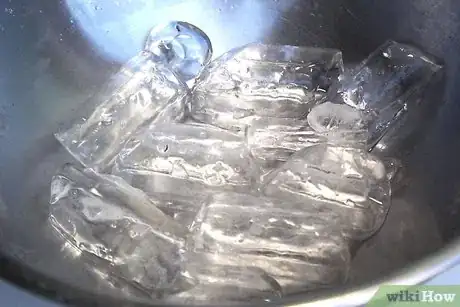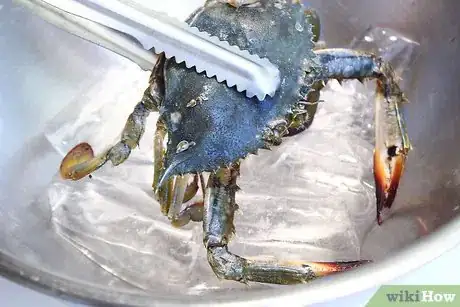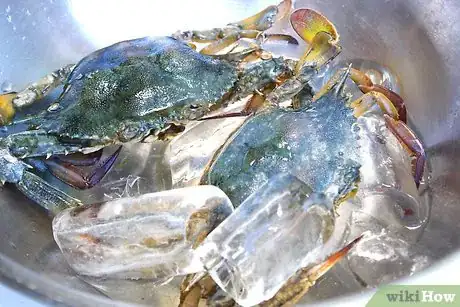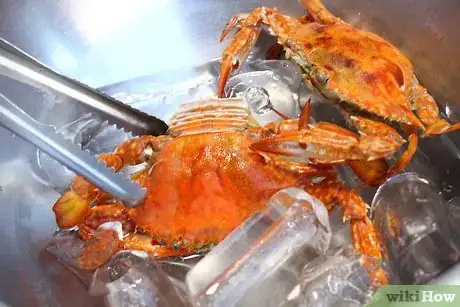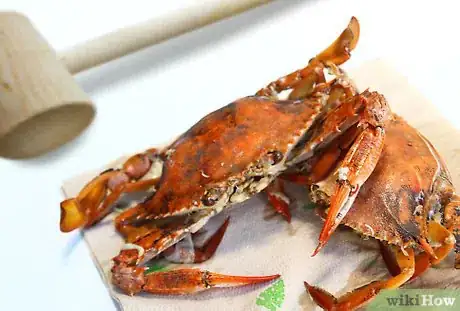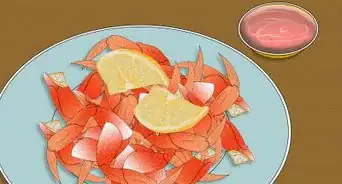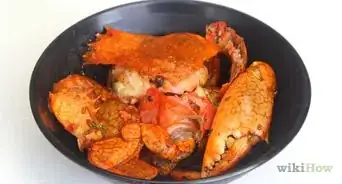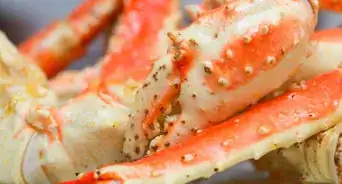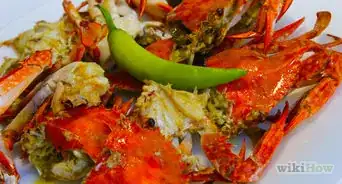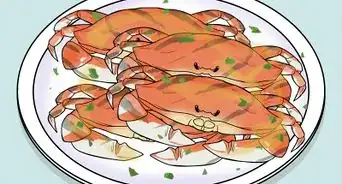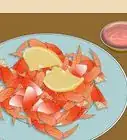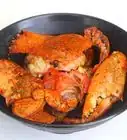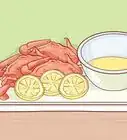This article was co-authored by Ashley Crawford. Chef Ashley Crawford is a Private Chef and the Founder of A Taste of Chef Ash. Chef Ashley started in the culinary industry when she was 14. She specializes in Creole and Cajun cuisine but has experience in all culinary topics. She has been featured in ESPN and Sports Illustrated for her culinary work with athletes.
There are 13 references cited in this article, which can be found at the bottom of the page.
This article has been viewed 49,093 times.
Blue crabs are native to the Atlantic Coast of the United States and the Gulf of Mexico, but are enjoyed around the world for their sweet and tender meat.[1] Whether you picked some up at a local market or caught them yourself, the most popular way to prepare blue crabs is to boil them live. It only takes about 45 minutes total to prepare and boil blue crabs, leaving you with tender, juicy crab meat to enjoy.
Ingredients
- 2 dozen live blue crabs
- ½ cup sea salt
- 3 tbsp Old Bay seasoning or crab boil
- 2 sliced lemons
Steps
Putting the Crabs to “Sleep”
-
1Fill an empty sink or bucket with ice water. Make sure whatever container you use is large enough to accommodate the crabs as well as the ice water. You want to have enough water and ice to ensure the crabs will be fully submerged.
-
2Place the crabs into the ice bath using long metal tongs. Crabs’ claws are sharp and, before you submerge them, the crabs are likely to be active. Be careful not to get pinched.
- Submerging live crabs in ice water puts them into a dormant state.[2] This makes the boiling process more humane and also makes it easier to place them into the pot to boil.
Advertisement -
3Leave the crabs to sit in the ice bath for 5-10 minutes. This is enough time to put the crabs into their dormant state.[3] Before you remove them, however, you’ll want to make sure that they are inactive.
- Use long metal tongs to pull one crab out of the ice bath. If it is still moving around, put it back in and add more ice if necessary.
-
4Remove the crabs from the ice bath only when you're ready to boil them. You’ll want to make sure the crabs are still in a dormant state when you submerge them in boiling water, so it’s important to have your pot of water ready to go when you take them out of the ice bath.[4]
Preparing and Seasoning the Water
-
1
-
2Add ½ cup of sea salt, 2 sliced lemons, and 3 tbsp of Old Bay seasoning. Stir these ingredients in with the water. This will provide added flavor to the crab and the salt will also increase the boiling point of the water, helping to cook the crab more thoroughly.[7]
- You may also choose to add garlic, dill, paprika, cumin, and/or other spices.
-
3Place the pot over high heat and bring the water to a rolling boil. A rolling boil means you’ll see large, active bubbles on the surface of the water.[8] You should also be able to stir the water without disturbing the boil.
- You’ll want to keep this rolling boil going while you add the crabs and throughout the entire cooking process.[9]
Cooking the Crabs
-
1Lower the crabs headfirst into the water carefully to avoid splashing.[10] The best way to do this is to take the crabs out of the ice bath one by one using long metal tongs, and gently drop each one into the pot of boiling water. This process is much easier because the crabs are already in a dormant state.
- Put the crabs in a boiling basket and lower it into the water. That way, it's easier to pull them all out when they're finished cooking.[11]
-
2Cover the pot and boil the crabs continuously for 15-20 minutes. Keep the pot over high heat and avoid lifting the lid too often.[12] This will help keep the water at a consistent rolling boil and help the crabs cook through.
-
3Check the crabs to see if the shells are red and the meat is tender. If you’re not sure if they’re done, pull one crab out and inspect it more closely. To check the meat, simply tear off a claw and crack it open.[13]
-
4Take the crabs out of the pot and put them in ice water for 5-10 minutes. You’ll want to cool the crabs off as quickly as possible to make sure they don’t continue to cook in their shells after you’ve pulled them out.
- You can use the same bucket or sink you used when you put the crabs to sleep. Simply add more ice, and then use tongs to transfer the crabs from the boiling water to the ice bath.[14]
-
5Remove the crabs from the ice water and drain them in a colander. This will help remove any excess water. Gently shake the crabs to speed up this process.
-
6Protect the table with a cloth and set out mallets and crushing tools. You’ll also want to have meat-picking forks, bibs, plenty of napkins, and a bucket for discarding shell pieces.[15] Crab is delicious, but can be a bit messy to eat.
- If you’re in a casual setting, laying down newspaper can be a great way to protect your table and make cleaning up easier.[16] If you’re in a more formal setting, you can always lay newspaper down under a fancier table cloth.
-
7Serve the crab on a platter with melted butter or other dipping sauce. Now that you’ve cooked and cleaned your crabs, it’s time to enjoy them!
- If you want to serve your crab with a side or two, blue crab pairs well with french fries, coleslaw, roasted vegetables, salad, corn on the cob, and mashed or baked potatoes.[17]
Warnings
- You’ll want to be very careful anytime you’re handling live crabs. It’s a good idea to use long metal tongs to avoid getting pinched.⧼thumbs_response⧽
- It’s important to cook crabs alive. Crab meat can spoil very quickly and you don’t want to get sick.[18]⧼thumbs_response⧽
Things You’ll Need
- Large stockpot
- Long metal tongs
- Ice
- Timer
- Colander
- Table cloth
- Serving platter
- Bibs
- Napkins
- Crab mallet
- Crushing tool
- Meat-picking forks
- Bucket
References
- ↑ https://oceana.org/marine-life/cephalopods-crustaceans-other-shellfish/atlantic-blue-crab
- ↑ https://www.affordable-cape-cod-vacations.com/cooking-blue-crab.html
- ↑ https://foodal.com/knowledge/how-to/crabs-ultimate-guide-to-buying-preparing-and-cooking/
- ↑ https://www.nola.com/food/index.ssf/2016/08/how_to_boil_crabs_bevi_seafood.html
- ↑ https://foodal.com/knowledge/how-to/crabs-ultimate-guide-to-buying-preparing-and-cooking/
- ↑ [v162186_b01]. 16 October 2022.
- ↑ http://www.foodrepublic.com/2011/12/05/should-you-add-salt-to-boiling-water/
- ↑ https://www.merriam-webster.com/dictionary/rolling%20boil
- ↑ https://www.affordable-cape-cod-vacations.com/cooking-blue-crab.html
- ↑ https://www.myrecipes.com/recipe/simple-boiled-crabs
- ↑ [v162186_b01]. 16 October 2022.
- ↑ https://www.affordable-cape-cod-vacations.com/cooking-blue-crab.html
- ↑ https://www.rachaelraymag.com/recipe/maryland-blue-crab-boil-with-beer-and-old-bay
- ↑ https://www.turntablekitchen.com/recipes/how-to-cook-live-crab-at-home-paired-with-harissa-lemon-garlic-butter/
- ↑ https://www.affordable-cape-cod-vacations.com/cooking-blue-crab.html
- ↑ https://www.washingtonpost.com/blogs/all-we-can-eat/post/how-to-throw-a-proper-blue-crab-feast/2012/08/30/3b677ea2-f081-11e1-ba17-c7bb037a1d5b_blog.html?noredirect=on&utm_term=.f19646b6f06e
- ↑ http://www.foodrepublic.com/2014/07/23/how-to-cook-a-proper-blue-crab-feast/
- ↑ https://www.fda.gov/food/resourcesforyou/consumers/ucm077331.htm
